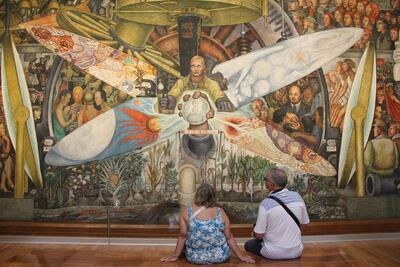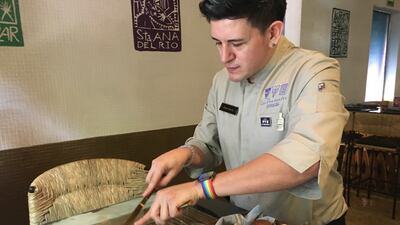Latin America’s largest metropolis can be intimidating for the first time visitor, but follow a few key tips and it is possible to plunge into Mexico City's unique past, from pre-Hispanic culture through the baroque golden age of Spain’s colonial conquistadores through revolution, independence and today’s vibrant art and architecture scene.
While the metro and bus systems are efficient and safe, to get around swiftly stick to Uber, resist the temptation to hail a street cab, and you'll enjoy 72 hectic, exciting and fun hours in Mexico's capital.
Day One: Downtown treasures

The ideal base for exploring CDMX as everyone calls Mexico City is the downtown Centro Historico around the landmark Zocalo square. There are plenty of hotels to choose from, but difficult to beat is the fashionable Umbral, housed in a renovated Art Deco bank, with arty designer rooms and rooftop pool.
Head out early the first morning to explore downtown, beginning at La Merced, a dazzling, chaotic food market that dates back to the 1300s. Marvel at the multicoloured chillies, tropical fruits, piles of cactus leaves and wild mushrooms then enjoy a traditional street food breakfast of steamed fish tamales or, if you're feeling adventurous, pancita or beef tripe soup.
The immense Zocalo is one of the world’s largest squares, and the perfect introduction to CDMX with its sacred ruins of the original Aztec city of Tenochtitlan in the recent Templo Mayor archeological excavations, alongside gothic and baroque monuments of colonial New Spain symbolised by the National Palace and Cathedral. The downtown side streets are lined with lavish post-independence buildings in a unique Mexican style, from a palatial Post Office inspired by Venice’s Doges Palace to 1890s department stores that mirror La Samaritaine and Galeries Lafayette in Paris. Soak up this very special atmosphere over lunch in House of Tiles, an 18th century baroque mansion adored by locals for its affordable and tasty tacos, tamales and enchiladas. It prepares you for an unforgettable afternoon of museum visiting, beginning with the grandiose Palacio de Bellas Artes, where the murals collection showcases the best of Mexico’s hallmark political murals, above all the controversial masterpiece of Diego Rivera, Man, Controller of the Universe.
Head to the Museo de Arte Popular, a hidden gem that's housed in an Art Deco fire station and presents a visually stunning exhibition of Mexico’s artisan folk crafts, spanning textiles, pottery, glass, paper-mache. Having survived all this on the first day, head back to the peaceful oasis of the Umbral and enjoy a gourmet dinner of creative Mexican cuisine in the elegant Paixa restaurant, tasting authentic dishes such as plump shrimp flambee in pulque sauce.
Day two: Museums, markets and more

Skip the hotel breakfast and walk over to the venerable Pasteleria Ideal for cafe con leche and a selection of irresistible cakes and pastries, then grab an Uber to La Ciudadela, a maze-like artisans market that's perfect for souvenir shopping. The quality is high here, though you need to bargain for the best prices for everything from colourful Indian masks and textiles, glassware and garish Day of the Death figurines.
A drive along the grand Reforma boulevard brings you out in the exclusive Polanco neighbourhood and verdant Chapultepec park, home of the city’s famed National Anthropology Museum. In the same league as the Louvre, British Museum or Smithsonian, the collection of pre-Hispanic art is immense and unparalleled, clearly explaining the cultured, complex world of Mexico’s indigenous Olmec, Mayan and Aztec people. After a marathon visit here, a good lunch is necessary, and the place to reserve is the 17th century colonial Hacienda de los Morales, a reminder that chic Polanco was once farming land. Converted today into a grand restaurant, guests come for the old-fashioned service and classics such as tortilla soup with cheese and avocado, seabass ceviche or stuffed peppers in a nutty nogada sauce.
Polanco has a huge shopping mall adjoining two recently completed private modern art museums housed in spectacular futuristic architecture. Museo Soumaya resembles the Guggenheim Bilbao and showcases the private collection of Carlos Slim, Mexico’s richest man. He has donated all his artworks to the nation – Monet, Manet, Gauguin, Titian, and dozens of Rodin sculptures – and entrance is free. Right opposite is the more minimalist Jumex, which hosts blockbuster temporary exhibitions devoted to the likes of Damien Hirst.
End the afternoon by exploring La Condesa, the city’s most cosmopolitan neighbourhood, with fashion and design boutiques, cool cafe terraces and the lively Espana Park, where locals walk their numerous dogs and take outdoor classes in Thai boxing, yoga and tango. To spend the most surprising and entertaining evening in town, arrive at Arena Mexico by 7.30pm. Home of the nation’s famed Lucha Libre masked wrestling, it plays host to 10,000 avid fans three times per week and is a flurry of thrilling competition performed by incredibly athletic male and female stars. The atmosphere is electric, fun for all the family and it could very well be the highlight of your trip.
Day three: Floating gardens and historic cantinas

An hour drive from the Zocalo takes you to the magical floating gardens of Xochimilco, a paradise for biodiversity, and the last remnants of the immense lakes upon which the original Mexico City was built by indigenous people. Everyone explores this Unesco World Heritage Site by hiring a brightly painted trajinera boat, languidly punted through a maze of lush canals. With serenading mariachis ready to board, small boats offering tacos and corn cobs, flower garlands and sombreros, the experience is totally kitsch but irresistible and memorable. Be sure to stop in the buzzing local food market, as smallholder farmers on the wetlands "chinampa" islands cultivate highly prized vegetables, with food stalls selling delicious quesadillas stuffed with rare huitlacoche mushrooms and spicy cactus salads.
For lunch, head into the romantic neighbourhood of Coyocan, whose baroque churches, ornate Liberty villas, parks, cafes and bistros make it the most popular spot for Mexicans at the weekend. Tourists make an obligatory visit to the Frida Kahlo Museum, the stunning cobalt-blue mansion and gardens that has been perfectly preserved since it was home to the two superstars of contemporary Mexican art, Frida Kahlo and Diego Rivera. Reservation is essential, though you still have to put up with big crowds.
For a genuine slice of Coyocan life, feast off traditional but creative Mexican cuisine at hip diner Los Danzantes, serving the city's best duck enchiladas, one smothered in a rich chocolatey mole sauce, the other in a tangy green adobe. In the evening, back in the Zocalo, wander through the old city’s historic cantinas, stopping off for drinks at the opulent Art Nouveau Mancera, lavishly-tiled and frescoed Cafe de Tacuba, and then join Chilango locals and musicians in the 1920s Salon Espana, where you can tuck into a late comfort food supper of the signature Azteca steak with Oaxaca cheese and refried beans.












